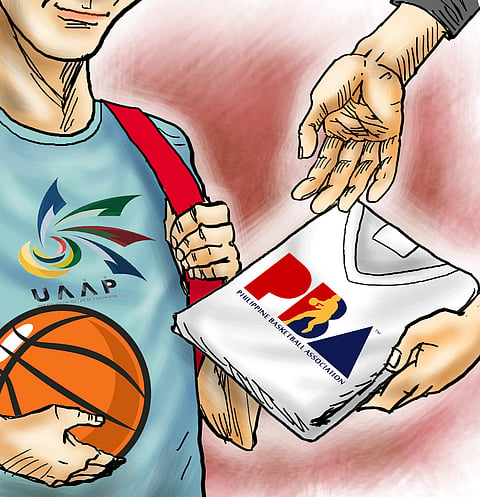
- NEWS
- the EDIT
- COMMENTARY
- BUSINESS
- LIFE
- SHOW
- ACTION
- GLOBAL GOALS
- SNAPS
- DYARYO TIRADA
- MORE

The Philippine Basketball Association’s (PBA) recent appeal to the University Athletic Association of the Philippines (UAAP) to allow its players to declare for the pro draft in the middle of a collegiate season is a bold and necessary move. It’s a pragmatic solution to a growing problem — the exodus of some of the country’s best young stars to foreign teams.
For years, the UAAP has rigidly prohibited players from joining the PBA while still committed to their collegiate teams.
The rationale is to ensure that student-athletes focus on their studies in a distraction-free season. But this innocent, well-meaning rule has become an unintended roadblock.
When the PBA holds its draft in the middle of the collegiate season, UAAP players who have exhausted their playing years and are ready to turn professional are forced to sit it out for a full year, forcing them to play in semi-pro leagues, or worse, go abroad to stay in shape.
In short, this is a system that doesn’t benefit anyone.
In his letter to the UAAP Board of Managing Directors recently, PBA Commissioner Willie Marcial made a very compelling case.
Marcial assured the UAAP that being drafted won’t distract players from their academic and on-court duties, and the PBA and its member teams will support these athletes. This isn’t just a matter of convenience; it’s about creating a clearer and more attractive pathway for our homegrown talent.
Let’s not kid ourselves: the current landscape is a testament to the flaws of the old rule. We have seen our top prospects like Francis Lopez, Juan Gomez de Liaño, Carl Tamayo, Thirdy Ravena, Dwight Ramos, SJ Belangel and Kai Sotto bypass the PBA entirely, opting to play in Japan, Dubai and Korea.
They have done so not out of a lack of desire to play in the PBA, but because the existing system is cumbersome and offers little flexibility.
The current system doesn’t answer their need to receive top-notch training while earning for their family at a young age. And with the UAAP’s maximum age of 25 years, they’d already missed a lot of opportunities by the time they decide to turn pro.
On the other hand, the National Collegiate Athletic Association (NCAA) has long allowed its players to join the PBA draft mid-season, provided they finish their collegiate commitments before joining the pro teams. It’s a model that works, balancing the needs of the player, the collegiate team, and the professional league.
The UAAP prides itself on being the premier collegiate league in the country.
To truly live up to that distinction, it must also be a springboard for their players’ professional careers—not a massive barrier.
The PBA’s proposal isn’t to raid the UAAP for talent; it’s about creating a seamless transition for the players. It will give them the security of knowing they have a professional home after their collegiate career, which will allow them to focus on finishing their season strong.
It is time for the UAAP to reconsider its long-held policy. A positive response would be a win-win solution for everyone.
It would benefit the players, who would have a more direct path to professional basketball. It would benefit the UAAP, which would continue to be a top source of talent for the pros. And, most importantly, it would benefit Philippine basketball, ensuring that the best and brightest Filipino stars will remain where they truly belong.
